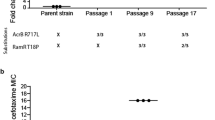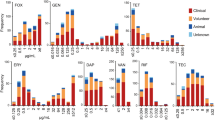Abstract
Here we report the genetic and proposed molecular basis for silver resistance in pathogenic microorganisms. The silver resistance determinant from a hospital burn ward Salmonella plasmid contains nine open reading frames, arranged in three measured and divergently transcribed RNAs. The resistance determinant encodes a periplasmic silver–specific binding protein (SilE) plus apparently two parallel efflux pumps: one, a P–type ATPase (SilP); the other, a membrane potential–dependent three–polypeptide cation/proton antiporter (SilCBA). The sil determinant is governed by a two–component membrane sensor and transcriptional responder comprising silS and silR, which are co–transcribed. The availability of the sil silver–resistance determinant will be the basis for mechanistic molecular and biochemical studies as well as molecular epidemiology of silver resistance in clinical settings in which silver is used as a biocide.
This is a preview of subscription content, access via your institution
Access options
Subscribe to this journal
Receive 12 print issues and online access
$209.00 per year
only $17.42 per issue
Buy this article
- Purchase on Springer Link
- Instant access to full article PDF
Prices may be subject to local taxes which are calculated during checkout




Similar content being viewed by others
References
Gupta, A. & Silver, S. Silver as a biocide: will resistance become a problem? Nature Biotechnol. 16, 888 (1998).
Silver, S., Gupta, A. Matsui, K. & Lo, J.–F. Resistance to Ag(I) cations in bacteria: environments, genes and proteins. Metal Based Drugs (in the press).
George, N., Faoagali, J. & Muller, M. SilvazineTM (silver sulfadiazine and chlorhexidine) activity against 200 clinical isolates. Burns 23, 493–495 (1997).
Modak, S. M., Sampath, L. & Fox, C.L. Jr. Combined topical use of silver sulfadiazine and antibiotics as a possible solution to bacterial resistance in burn wounds. J. Burn Care Rehabil. 9, 359– 363 (1988).
Pruitt, B.A. Jr., McManus, A.T., Kim, S.H. & Goodwin, C.W. Burn wound infections: current status. World J. Surg. 22, 135–145 (1998).
Chu, C.S., McManus, A.T., Matylevich, N.P., Mason, A.D. Jr, & Pruitt, B.A. Jr. Enhanced survival of autoepidermal–allodermal composite grafts in allosensitized animals by use of silver nylon dressings and direct current. J. Trauma 39, 273–278 (1995) .
Sampath, L.A., Chowdhury, N., Caraos, L. & Modak, S.M. Infection resistance of surface modified catheters with either short–lived or prolonged activity. J. Hosp. Infect. 30, 201–210 (1995).
Greenfeld, J.I. et al. Decreased bacterial adherence and biofilm formation on chlorhexidine and silver sulfadiazine–impregnated central venous catheters implanted in swine. Crit. Care Med. 23, 894– 900 (1995).
Gabriel, M.M., Mayo, M.S., May, L.L., Simmons, R.B. & Ahearn, D.G. In vitro evaluation of the efficacy of a silver–coated catheter. Curr. Microbiol. 33, 1– 5 (1996).
McHugh, S.L., Moellering, R.C., Hopkins, C.C. & Swartz, M.N. Salmonella typhimurium resistant to silver nitrate, chloramphenicol, and ampicillin. Lancet i, 235– 240 (1975).
Annear, D.I., Mee, B.J. & Bailey, M. Instability and linkage of silver resistance, lactose fermentation and colony structure in Enterobacter cloacae. J. Clin. Path. 29, 441–443 (1976).
Bridges, K., Kidson, A., Lowbury, E.J.L. & Wilkins, M.D. Gentamicin– and silver–resistant Pseudomonas. Brit. Med. J. 1, 446–449 (1979).
Silver, S. & Phung, L.T. Bacterial heavy metal resistance: new surprises. Annu. Rev. Microbiol. 50, 753–789 (1996).
Silver, S. Genes for all metals—a bacterial view of the Periodic Table. J. Indust. Microbiol. Biotech. 20, 1– 12 (1998).
Hobman, J.L. & Brown, N.L. in Metal Ions in Biological Systems Vol. 34 (eds. Sigel, A. & Sigel, H.) 527– 568 (Marcel Dekker, New York, 1997).
Summers, A.O. Untwist and shout: a heavy metal–responsive transcriptional regulator. J. Bacteriol. 174, 3097– 3101 (1992).
Gupta, A., Maynes, M. & Silver, S. The effects of halides on plasmid silver resistance in Escherichia coli. Appl. Environ. Microbiol. 64, 5042–5045 (1998).
Brown, N.L., Barrett, S.R., Camakaris, J., Lee, B.T. O. & Rouch, D.A. Molecular genetics and transport analysis of the copper–resistance determinant (pco) from Escherichia coli plasmid pRJ1004. Mol. Microbiol. 17, 1153–1166 (1995).
Hoch, J.A. & Silhavy, T.J. (eds.) Two–Component Signal Transduction (ASM, Washington, DC, 1995).
Rouch, D.A. & Brown, N.L. Copper–inducible transcriptional regulation at two promoters in the Escherichia coli copper resistance determinant pco. Microbiology 143, 1191– 1202 (1997).
Blattner, F.R. et al. The complete genome sequence of Escherichia coli K–12. Science 277, 1453–1474 (1997).
Rudd, K.E. Linkage map of Escherichia coli K–12, Edition 10: The physical map. Microbiol. Mol. Biol. Rev. 62, 985– 1019 (1998).
van der Lelie, D. et al. Two–component regulatory system involved in transcriptional control of heavy– metal homoeostasis in Alcaligenes eutrophus. Mol. Microbiol. 23, 493–503 (1997).
Nies, D. H. & Silver, S. Ion efflux systems involved in bacterial metal resistances. J. Indust. Microbiol. 14, 186–199 (1995).
Nies, D. H. The cobalt, zinc, and cadmium efflux system CzcABC from Alcaligenes eutrophus functions as a cation–proton antiporter in Escherichia coli. J. Bacteriol. 177, 2707– 2712 (1995).
Paulsen, I.T., Park, J.H., Choi, P.S. & Saier, M.H. Jr. A family of gram–negative bacterial outer membrane factors that function in the export of proteins, carbohydrates, drugs and heavy metals from gram–negative bacteria. FEMS Microbiol Lett. 156, 1– 8 (1997).
Solioz, M. & Vulpe, C. CPx–type ATPASE: a class of P–type ATPASE that pump heavy metals. Trends Biochem. Sci. 21, 237–241 (1996).
Trenor III, C., Lin, W. & Andrews, N.C. Novel bacterial P–type ATPases with histidine–rich heavy–metal–associated sequences. Biochem. Biophys. Res. Commun. 205, 1644–1650 (1994).
Li, X. Z., Nikaido, H. & Williams, K. E. Silver–resistant mutants of Escherichia coli display active efflux of Ag+ and are deficient in porins. J. Bacteriol. 179, 6127– 6132 (1997).
Solioz, M. & Odermatt, A. Copper and silver transport by CopB–ATPase in membrane vesicles of Enterococcus hirae. J. Biol. Chem. 270, 9217–9221 (1995).
Ausubel, F.M., et al. (eds.) Current Protocols in Molecular Biology (John Wiley & Sons, New York, 1998).
Rech, S., Wolin, C. & Gunsalus, R.P. Properties of the periplasmic ModA molybdate–binding protein of Escherichia coli. J. Biol. Chem. 271, 2557–2562 (1996).
Acknowledgements
We thank A.O. Summers for the plasmid used in this work and for unpublished data, F. Roberto and P. Goodlove for sequencing and analysis, B.–S.B. Lee for N–terminal polypeptide sequencing and advice, and W. Hendrickson, W. Walden, and D.H. Nies for discussions. This work was supported by a grant from the Department of Energy.
Author information
Authors and Affiliations
Corresponding author
Rights and permissions
About this article
Cite this article
Gupta, A., Matsui, K., Lo, JF. et al. Molecular basis for resistance to silver cations in Salmonella. Nat Med 5, 183–188 (1999). https://doi.org/10.1038/5545
Received:
Accepted:
Issue Date:
DOI: https://doi.org/10.1038/5545
This article is cited by
-
Systematic analyses identify modes of action of ten clinically relevant biocides and antibiotic antagonism in Acinetobacter baumannii
Nature Microbiology (2023)
-
Mutations in SilS and CusS/OmpC represent different routes to achieve high level silver ion tolerance in Klebsiella pneumoniae
BMC Microbiology (2022)
-
Laser ablation assisted micropattern screen printed transduction electrodes for sensing applications
Scientific Reports (2022)
-
Role of bacterial motility in differential resistance mechanisms of silver nanoparticles and silver ions
Nature Nanotechnology (2021)
-
Nanoparticle treatment of maize analyzed through the metatranscriptome: compromised nitrogen cycling, possible phytopathogen selection, and plant hormesis
Microbiome (2020)



